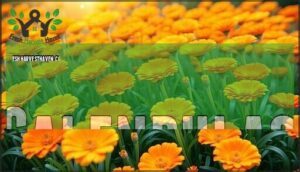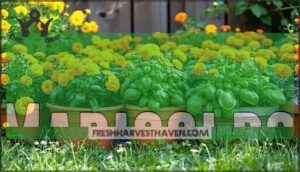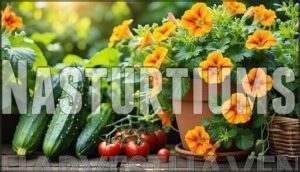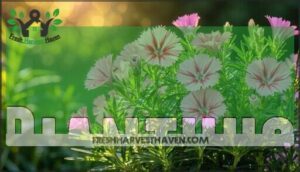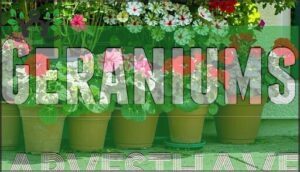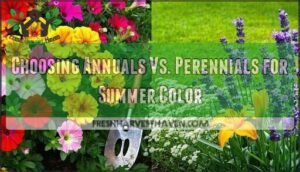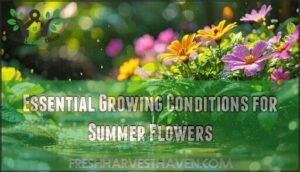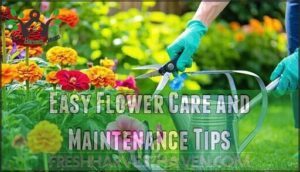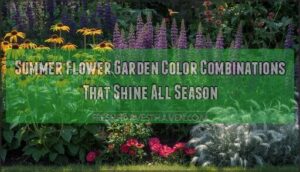This site is supported by our readers. We may earn a commission, at no cost to you, if you purchase through links.

The best summer flowers for beginners don’t demand perfect soil, obsessive watering schedules, or a degree in horticulture. They just need sun, occasional water, and maybe a pep talk on slow mornings.
Whether you’re working with a sunny backyard or a few containers on a balcony, these twelve easy-care bloomers will transform your space from "I tried" to "Wait, I actually did that" before July hits.
Table Of Contents
Key Takeaways
- The twelve easiest summer flowers for beginners (including marigolds, zinnias, sunflowers, and cosmos) thrive with minimal care—they just need sun, occasional water, and can tolerate beginner mistakes while delivering continuous blooms throughout the season.
- Annuals provide instant, nonstop color all summer but require replanting yearly, while perennials return each year with stronger roots and less maintenance after the first season, though they bloom for only 3-6 weeks annually.
- Essential growing conditions include at least six hours of direct sunlight daily, well-drained soil with a pH of 6.0-7.0, deep watering twice weekly instead of daily sprinkles, and a two-inch layer of organic mulch to retain moisture and reduce watering needs.
- Simple maintenance habits like deadheading spent blooms, companion planting with pest-repelling flowers like marigolds and nasturtiums, and choosing native pollinator-friendly varieties with staggered bloom times will keep your garden healthy and attract beneficial insects naturally.
Top 12 Easiest Summer Flowers for Beginners
Summer gardening doesn’t have to be complicated, especially when you start with flowers that practically grow themselves. The twelve varieties below are proven winners for beginners—they forgive mistakes, tolerate heat, and reward you with gorgeous blooms all season long.
Let’s look at each one so you can pick the perfect additions for your garden.
Black-Eyed Susans
Black-eyed Susans are the golden retrievers of the flower world—cheerful, dependable, and nearly impossible to mess up. These easy-to-grow flowers (Rudbeckia hirta) thrive in full sun and bloom all summer long, making them perfect for beginner gardening.
Plant them in garden design schemes with companion plants like coneflowers and ornamental grasses. They’re wonderful as cut flowers, and propagation methods include dividing clumps in spring!
Calendulas
Calendulas (Calendula officinalis) are cheerful, no-fuss annuals that practically grow themselves—and as a bonus, you can toss their bright petals right into your salad. These easy-to-grow flowers have medicinal properties too, soothing skin irritations when used in salves.
For variety selection, try ‘Pacific Beauty’ or ‘Resina’ for stunning summer flowers. Use propagation methods like direct sowing every few weeks for continuous blooms.
Companion planting with vegetables helps deter aphids naturally—making calendulas both beautiful and useful in your flower gardening tips arsenal!
Cosmos
If calendulas are your cheerful helpers, Cosmos (Cosmos bipinnatus) are the carefree party guests who show up, look gorgeous, and never ask for a thing. These easy to grow flowers thrive in hot, dry spots—perfect for beginner gardening.
Try Cosmos varieties like ‘Sensation Mix’ for stunning cut flowers, and save seeds for next year’s blooms. Plant companion plants like marigolds nearby.
Cosmos pests rarely bother these tough summer flowers, making them ideal flower varieties for beginners.
Marigolds
Marigolds (Tagetes) are the workhorses of the summer garden—tough, reliable, and they’ll keep blooming through heat waves and dry spells that would make other flowers quit. These easy to grow flowers are perfect for flower gardening beginners, and they’re natural mosquito repellent too!
Quick wins with marigolds:
- Grow them for companion planting near vegetables—they deter pests naturally
- Try container gardening with compact French marigolds
- Enjoy deadheading benefits for nonstop blooms (plus, some have edible petals!)
Water deeply when soil feels dry, and watch your summer flowers thrive.
Nasturtiums
With those peppery, colorful leaves and flowers you can actually eat, nasturtiums (Tropaeolum) are the edible showstoppers that practically grow themselves while attracting every pollinator in the neighborhood.
These easy to grow flowers thrive as companion plants near cucumbers and tomatoes, providing natural pest control by luring aphids away.
Perfect flowers for beginners, they grow quickly from seed and tolerate poor soil—just give them sun and watch your summer flowers cascade beautifully.
Sunflowers
Standing tall like nature’s skyscrapers, sunflowers (Helianthus annuus) are the cheerful giants that turn any garden into a summer celebration—and they’re ridiculously easy to grow from seed. These easy to grow flowers are perfect flowers for beginners looking to add drama to their flower garden.
Growing sunflowers successfully:
- Planting sunflowers directly in full sun with moist, well-drained soil produces the strongest stalks
- Choose from countless sunflower varieties—from towering 12-footers to compact dwarf types for containers
- Watch for sunflower pests like birds and squirrels when harvesting seeds for snacks or next year’s planting
These drought and heat-tolerant summer flowers bloom reliably all season, offering both beauty and sunflower uses from cut flowers to edible seeds.
Zinnias
If you’re after garden gold without the fuss, zinnias (Zinnia elegans) deliver show-stopping color in every shape imaginable—from button-sized pompoms to dinner-plate dahlias—while practically growing themselves.
These easy to grow plants thrive in full sun with moderate water, making them ideal flowers for beginners who want a striking cut flower garden.
Zinnia varieties attract butterflies by the dozen, and simple zinnia propagation from seed means endless zinnia arrangements all summer—just watch for powdery mildew in humid conditions.
Sweet Alyssum
Sweet alyssum (Lobularia maritima) proves that the best things come in tiny packages—these delicate, honey-scented blooms spill over garden edges like fragrant clouds while asking almost nothing in return.
This annual flower shines in container gardening and planting combinations, preferring full sun but tolerating some shade. Propagation methods are simple—direct sow seeds for summer flowers that self-seed freely.
These easy-to-grow plants make gardening for beginners a breeze, though winter care isn’t needed since they’re true annuals.
Coneflowers
Coneflowers (Echinacea) are the tough-as-nails perennials that laugh at drought, shrug off pests, and bloom their heads off for months without demanding a single thing from you. These easy-to-grow plants thrive in full sun with minimal water once established, making them perfect for beginner gardening.
Coneflower varieties range from classic purple to coral and white—all offering impressive Echinacea benefits as companion plants alongside black-eyed Susans or zinnias.
Skip deadheading if you want winter interest and seed for birds, or remove spent blooms to encourage more summer flowers.
Dianthus
Dianthus delivers spicy-scented blooms and evergreen foliage that deer won’t touch, making it one of the most rewarding perennials you can tuck into sunny spots or rock gardens.
Dianthus varieties include cottage pinks and Sweet Williams—all offering fragrant flowers and impressive deer resistance.
These easy-to-grow plants produce summer blooms in full sun with well-drained soil, serving as low-maintenance perennial flowers with striking evergreen foliage year-round.
Daylilies
Daylilies earn their name by producing fresh blooms daily throughout summer—each flower lasts just one day, but the show runs for weeks without any fuss from you. Daylily varieties offer extended bloom periods and work beautifully with companion plants in your garden design.
These perennial flowers are easy to grow plants that reward you with reliable summer blooms:
- Tolerate drought and poor soil like champions
- Multiply through simple daylily propagation by division
- Flourish in full sun to partial shade
- Resist deer and most pests naturally
- Require zero deadheading for continuous flower gardening success
Geraniums
Geraniums deliver foolproof color from spring through frost with practically zero drama—just plant them in sunny spots and watch them work their magic all season long. Geranium varieties range from classic blooms to scented geraniums with fragrant leaves.
These easy to grow plants thrive in container gardening and require minimal plant care—water when dry, pinch off spent blooms, and enjoy reliable summer blooms all season.
Choosing Annuals Vs. Perennials for Summer Color
When you’re mapping out your summer garden, one of your first decisions is whether to plant annuals, perennials, or a mix of both. Each type brings its own advantages to the table, and understanding what sets them apart helps you build a garden that matches your goals and effort level.
Let’s break down the key differences, benefits, and top picks for each category.
Key Differences Between Annuals and Perennials
When planning your garden, understanding annual and perennial flowers helps you choose what fits your goals. Annuals complete their entire life cycle in one season—they sprout, bloom, and die within a year. Perennials return year after year, regrowing from their roots each spring. Both offer unique benefits, but perennials offer reliable blooms.
| Feature | Annuals | Perennials |
|---|---|---|
| Lifespan comparison | One growing season | 2+ years, some live decades |
| Bloom duration | Continuous all season | 3-6 weeks per year |
| Maintenance needs | Replant yearly, frequent watering | Prune occasionally, less upkeep |
| Environmental adaptation | Thrive in variable conditions | Prefer stable environments |
| Garden impact | Instant, vibrant color | Long-term structure and continuity |
Annual flower varieties like marigolds and zinnias give you nonstop blooms throughout summer, while perennial flower varieties such as coneflowers establish stronger roots and require less fussing once settled.
Benefits of Each for Beginner Gardeners
Both annuals and perennials offer distinct advantages for beginners. Annuals provide instant gratification, with vibrant summer blooms appearing within weeks. They are ideal for learning basic planting skills and experimenting with color. Perennials, on the other hand, require patience but reward you with returning blooms and stronger root systems that improve soil health over time.
Low-maintenance perennials like coneflowers teach you about seasonal cycles, while easy-to-grow plants such as marigolds excel at pest management. Marigolds also serve as a great option to attract beneficial insects to your garden. Choosing flowers for your garden becomes simpler once you match each type’s strengths to your learning goals and time commitment.
| Annuals | Perennials |
|---|---|
| Quick color, educational for beginners | Long-term investment, less replanting |
| High pollinator attraction all season | Established roots support soil stability |
| Perfect for testing garden layouts | Naturalize and reduce yearly garden inputs |
| Affordable experimentation with varieties | Lower water needs after first year |
Recommended Varieties for Each Type
Your top picks for summer bloomers combine carefree annual cultivars and reliable perennial options. Marigolds and zinnias excel as heat-tolerant flowers for beginners, while coneflowers and daylilies offer drought-resistant perennial choices. Both groups include excellent pollinator favorites and container choices, giving you flexibility when choosing flowers for your garden.
| Best Annual Cultivars | Top Perennial Options |
|---|---|
| Marigolds (over 50 varieties) | Coneflowers (15+ cultivars) |
| Zinnias (‘State Fair Mix’) | Daylilies (thousands of hybrids) |
| Cosmos (12 seed varieties) | Hardy geraniums (multi-season bloomers) |
| Nasturtiums (7+ colors) | Lavender (drought-resistant stalwart) |
Essential Growing Conditions for Summer Flowers
Getting your summer flowers to thrive isn’t complicated—it just takes a few smart decisions about sun, soil, water, and food. Each flower has its own preferences, but most summer bloomers share similar basic needs.
Let’s break down the essential growing conditions that’ll help your beginner garden flourish all season long.
Sunlight Requirements and Placement
Your garden orientation and flower placement determine everything—think of sunlight as the fuel your flowers need. Most summer blooms need full sun, which means at least six hours of direct sunlight daily. South-facing gardens deliver the most sun exposure, perfect for sun-lovers like zinnias and marigolds. East-facing spots capture gentler morning light, ideal for partial shade plants.
Track sunlight patterns with your smartphone throughout the day to assess light duration accurately. Trees and buildings create shade impacts that shift with seasons, so observe your space carefully before planting.
Soil Preparation and Drainage Needs
Healthy roots need room to breathe, and that starts with the soil beneath your feet. Most summer flowers thrive in well-drained soil with a slightly acidic to neutral soil pH (6.0-7.0). Test your soil conditions before planting:
- Mix compost or aged manure as soil amendments to improve texture
- Guarantee drainage solutions like raised beds for heavy clay soil types
- Use quality container soil with perlite for pots
- Check soil temperature reaches 60°F before planting tender varieties
Good drainage prevents root rot and keeps your blooms happy all season.
Watering Techniques for Hot Weather
When the mercury climbs and the sun beats down relentlessly, your watering strategy can make or break your summer blooms. Deep watering twice weekly beats daily sprinkles—it encourages stronger roots and prevents drought stress. Water early morning to minimize evaporation and support water conservation.
Mulch benefits include keeping soil conditions moist longer. Heat-tolerant flowers and drought-tolerant summer bloomers still need consistent moisture during peak heat!
Fertilizer Tips for Healthy Blooms
Think of fertilizer as your flowers’ morning coffee—it gives them the energy boost they need to produce those show-stopping blooms all season long. Use a balanced 10-10-10 nutrient ratio for most summer bloomers, or choose bloom boosters higher in phosphorus for extra flowers.
Apply organic fertilizer monthly or water-soluble types every two weeks. Granular application methods work great for beds, while liquid fertilizers feed container plants quickly.
Easy Flower Care and Maintenance Tips
Once your flowers are in the ground and growing, a few simple maintenance habits will keep them healthy and blooming all summer long. These basic care techniques work for nearly all beginner-friendly flowers and take just minutes each week.
Here’s what you need to know to keep your garden looking its best.
Pest and Disease Prevention
Keeping pests and diseases at bay doesn’t have to feel like an uphill battle—a few smart habits can save your blooms before trouble even starts. Check leaves regularly for aphids and spider mites, then blast them off with water or use insecticidal soap. Plant insect repellent plants like marigolds and nasturtiums for natural pest control. Choose deer resistant varieties like dianthus if wildlife nibbles your garden.
Good soil health and proper spacing prevent most fungal diseases before they take hold.
Deadheading and Pruning Basics
Snipping off spent blooms might feel tedious at first, but deadheading rewards you with waves of fresh flowers instead of tired, seed-heavy stems. Use clean pruning tools to prevent disease spread and cut just above a leaf node. Zinnias, marigolds, and cosmos respond beautifully to regular deadheading.
Light shaping keeps plants bushy and prevents them from flopping over—these simple pruning techniques extend your bloom season by weeks.
Mulching for Moisture Retention
A two-inch blanket of organic mulch works like a cool drink of water for your soil, locking in moisture between waterings and keeping roots happy even when summer heat peaks.
Wood chips, shredded bark, or compost work beautifully as mulch types—just keep it a few inches away from flower stems to prevent rot.
This simple gardening tip cuts your watering frequency in half while improving soil conditions for healthier summer blooms.
Supporting Tall or Delicate Flowers
Once your mulch is in place, tall bloomers like sunflowers and daylilies often need a little extra help standing strong against summer storms and heavy flower heads. Simple staking techniques using bamboo poles or natural props work wonders for keeping your flower garden upright.
Try caging methods for bushier plants or trellis options for climbers—even weaving stems together provides wind protection! These basic flower gardening tips prevent snapped stems and keep your blooms looking gorgeous all season long.
Attracting Pollinators and Beneficial Insects
Your flower garden can become a buzzing hub of activity when you plant the right varieties. Pollinators like bees and butterflies don’t just add life to your space—they actually help your flowers thrive and produce more blooms.
Let’s look at how to turn your garden into a pollinator paradise with smart flower choices and simple layout strategies.
Best Flowers for Bees and Butterflies
You’ll want blooming flowers that deliver both nectar accessibility and pollen quantities to support pollinators. Purple coneflower, butterfly weed, and Indian blanket top the list for native bees, while milkweed is essential for monarch butterflies.
Bees favor blue, purple, and yellow flowers, whereas butterflies gravitate toward red and orange blooms. Planting at least seven different flower types boosts pollinator diversity by up to 67%, and asters extend late-season nectar when other flowers fade.
Companion Planting for Natural Pest Control
Pairing the right flowers together works like having a natural security system—certain plants repel pests while others draw in the beneficial insects that protect your garden. Marigolds and nasturtiums act as pest-repelling plants with insect repellent properties, while cosmos and sweet alyssum attract predators like ladybugs and lacewings.
Companion planting benefits extend beyond flower pest control—beneficial herbs like basil improve soil health and trap cropping with nasturtiums diverts aphids from your prized blooms, keeping pollinators safe and your garden thriving.
Creating a Pollinator-Friendly Garden Layout
Design your garden with layered planting zones—grouping tall flowers like sunflowers in the back, medium blooms like coneflowers in the middle, and low growers like sweet alyssum up front—so pollinators can easily navigate from bloom to bloom throughout the season.
Choose native plants with staggered bloom times to keep your flower garden design buzzing from spring through fall. Plant diversity creates better habitat creation, and don’t forget a shallow water source—bees need a drink too!
Frequently Asked Questions (FAQs)
How often should I water summer flowers?
Your summer bloomers need water when the top inch of soil feels dry—usually every 2-3 days in peak heat. Overwatering signs include yellow leaves and soggy roots.
Check soil moisture daily since climate impact varies widely.
When is the best time to plant summer flowers?
Plant after your local climate’s last frost date, when soil temperature stays warm enough for germination.
Start seed starting indoors 6-8 weeks early to extend your growing season and enjoy blooms sooner.
Can I grow summer flowers in containers?
Container gardening flowers thrive with proper container size, drainage solutions, and soil type. Choose compact varieties like zinnias, marigolds, and nasturtiums.
Guarantee adequate watering frequency since container plants dry faster than garden beds.
How do I winterize perennial summer flowers?
Protecting your perennial flowers through winter starts with understanding your hardiness zone. After the first frost triggers dormancy care, begin cutting back spent foliage. Apply a thick mulch layer to insulate roots, especially in colder zones.
Soil testing helps determine spring amendments.
What causes yellow leaves on summer flowers?
Yellow leaves on summer flowers usually signal overwatering issues, nutrient deficiencies, or poor sunlight exposure. Pest infestations and disease impact can also cause yellowing.
Check soil conditions, adjust watering, and guarantee proper light requirements for healthy flower care.
Conclusion
What if your summer garden didn’t need saving—just a little sun and water? That’s the beauty of the best summer flowers for beginners. These twelve varieties won’t ghost you after one hot week or demand expertise you don’t have.
Plant them where they’ll catch morning light, water when the soil feels dry, and deadhead spent blooms to keep the show going. You’re not just growing flowers—you’re building confidence one bloom at a time.
Start small, watch what thrives, and next summer you’ll wonder why you ever hesitated.
- https://www.gardendesign.com/flowers/easy.html
- https://www.gardenia.net/guide/summer-flowers-you-will-want-in-your-garden-this-year
- https://pennypenningtonweeks.com/1793/the-best-flowers-for-beginners-first-time-flower-growers/
- https://www.shrubhub.com/blog/set-it-and-forget-it-the-easiest-annual-flowers-for-hands-off-beauty-all-season-long.php
- https://trynutripod.com/blogs/nutripod-blog/new-to-gardening-try-these-beginner-friendly-flowers


